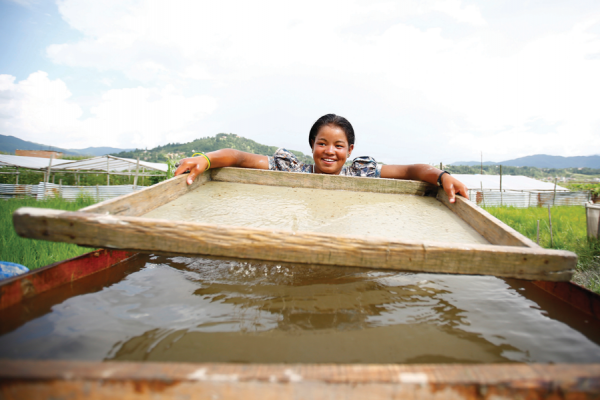Unique and Eco-Friendly Lokta Papers - Treasure of Nepal

Lokta has a huge demand in the foreign market
Lokta papers or Nepali Kagaz once solely used by the government for official uses is gaining popularity, and used in many ways. The popularity of these papers soared after the local manufacturers became aware of the different varieties of products they can make from these strong papers.
From tiny greeting cards and tea coasters to huge lamps and clocks, there is an escalating demand for lokta paper products in the market. Due to the papers’ durability and eco-friendly nature, environmentally conscious people have started substituting non-recyclable paper made products, plastic and glass products with lokta made products. Nicole Marquez, a tourist from Nicaragua who was buying a lokta paper lampshade along with several small sized bags from Mahaguthi, a handicraft store in Kathmandu stated, “I love these lokta made products. Not only are these products durable, beautiful and unique, but also contribute positively to the environment. The best thing about them is they are recyclable. In a world where we are struggling to save our environment, I would rather pay more for products and services that come from companies who are committed to positive social and environmental impact,” she added.
The markets for these papers have increased among businesses too. Restaurants around Thamel and Basantapur flaunt lokta made wall clocks and lamps among many other products to give their place a local, Nepali ambiance. Similarly, offices have started using lokta made desk accessories like files, file holders and pen holders.
How Are Lokta Papers Made?
Lokta papers can be preserved for a very long time period and unlike other papers they are non-perishable in the water, free from germs and highly resistant to insects. These papers are easy to dye and entirely hand-made. Additionally, these papers are highly recyclable.
Lokta papers are made of lokta, botanically known as Daphne Bhoula. Lokta is an indigenous plant of Nepal found at high altitudes. The bark of the Lokta has been used as raw materials for making these papers since ages. The best quality lokta sticks usually grow and exists at an attitude between 6000 to 10000 feet in the Himalayan forest of Nepal’s highlands.
Lokta plant is harvested by cutting its stem at ground level without destroying the main root. Lokta regenerates to maturity again within 4 to 5 years after being cut. The harvesting process actually helps the forest continue to grow because if the lokta is allowed to continue to grow past maturity, it would dry up and begin to decay, preventing any new growth. Thus, by plucking lokta sticks out, no harm is done to the fragile forest ecology. The hand production of lokta paper gives a source of income to paper crafting families and village communities in Nepal.
Lokta making process is simple and entirely hand-made. The process starts by cleaning the bark of the lokta with a sharp knife and chopping it into small pieces. These small pieces are then soaked in plain water for 5-6 hours. The pieces are then cooked in a soaking solution of hot water and soda for 1-2 hours and washed in cold water. Finally, the remnants are hammered and converted into pulp. The pulp is then poured into wooden frames for drying into sheets of paper.
Today, lokta paper ranks as one of Nepal’s top handicraft exports. After the paper found its way into the international market during the early 1990s, lokta businesses have escalated. While other handicrafts like pashmina and jewellery nosedived, handmade paper sales grew by over 300%. With the increase in socially conscious individuals and businesses, it seems like the eco-friendly and robust lokta paper is here to stay and flourish.
A Threat to the Lokta Industry
Sunil Shrestha, CEO of Shubham Handicrafts asserts that Lokta papers have a great future since they are the strongest papers in the world. However, even the strongest papers are now facing an existential threat because of fake lookalikes lokta papers made with Nepali broom grass (Thysanolaena Maxima). “Though the papers made with the broom grass look like Lokta, they are not as durable. Since many industries are now using broom grass and selling it off as lokta papers, a bad impression has been created. Now because of these few industries, many of our consumers have started questioning the quality of Lokta papers," states Shrestha. After the paper found its way into the international market during the early 1990s, lokta businesses have escalated. Sunil established his business in 2006 with his wife Meena Kumari Shrestha. During his interview, Shrestha stated that all of his goods are exported. He claims that among the various countries he exports to, his biggest consumers are from the UK and USA and his most popular product are diaries bound by original handmade leathers. When he first started, he and his wife used to produce all the good by themselves. Now, they manage the factory with 13 other people.
Lokta entrepreneurs today employ thousands of local employees just for lokta collection. Additionally, with the rising demand, the lokta industries’ needs for local workforces have significantly increased. This industry has not only increased the nations’ revenue but also positively contributed to the society and the environment of the country.
